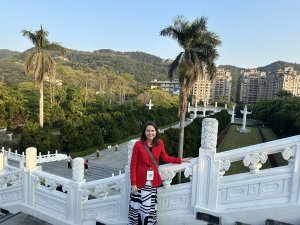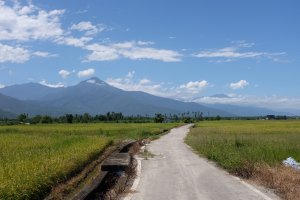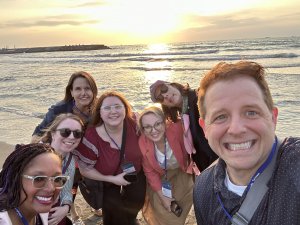Bridge Scour
The erosion of soil, sand, and riverbed materials near bridge foundations due to flowing water (or wind in some cases) is a phenomenon known as bridge scour. Despite our awareness of its occurrence, bridge scour remains one of the deadliest causes of overwater bridge failures worldwide, particularly in the United States and in Taiwan.
For instance, a notable scour-induced bridge collapse in the United States was the Schoharie Creek Interstate Highway Bridge incident in Mohawk River, New York, which happened in April 1987. The 32-year-old bridge collapsed due to extensive flood-induced scouring at one of its piers, and 10 people lost their lives. In Taiwan, similar incidents have occurred as well. More recently in September 2008, Typhoon Sinlaku brought heavy rainfall across many parts of Taiwan. The Houfeng Bridge collapsed due to flooding and severe scouring near one of its piers, although it was suspected that long-term riverbed degradation following the Chi-Chi earthquake in 1999 also contributed to its failure.
Events like these could be traced back through the histories of both countries. Even worse is that overwater bridge collapses after scouring continue to occur and threaten public safety. The inability to monitor scour, detect damage, and direct repair efforts lead to ineffective infrastructure management, high maintenance costs, and unsafe structures. Thus, there is an urgent need to devise ways to track bridge scour and to warn the public of (and prevent) pending disaster.
Importantly, a variety of technologies and techniques exist for monitoring bridge scour. One of the most common methods remains employing divers to conduct underwater visual inspections of bridge foundations. However, this approach is of limited effectiveness, especially since divers can only be deployed after typhoons or floods have subsided; in such cases, loose sand and soil can refill scour holes, thereby leading to a false diagnosis that the bridge is safe and that damage has not occurred. Murky waters and turbulent conditions also add to the challenges of visual inspection.
On the other hand, technologies such as sonar equipment, vibration and tilt sensors, magnetic sliding collars, and fiber optics have been implemented or are subjects of active research investigations. While some of these tools offer great promise, they also suffer from limitations such as being expensive, inaccurate, inaccessible, and unreliable. In short, the civil engineering community remains very much open to finding a high-performance, affordable, and reliable sensor solution for monitoring the progression of bridge scour.
Research Activities
The overarching goal of my research project (in collaboration with co-principal investigator Professor Fabian Bombardelli), which is funded by the U.S. National Science Foundation’s (NSF’s) Hazard Mitigation and Structural Engineering program (and its program manager, Professor Kishor Mehta), is to devise a sensing system that could directly measure the depth, shape, and overall topography of bridge scour holes and to do so in real-time.
The data generated would then be used to improve computational models of the bridge and flow environment, thereby improving our physical understanding of bridge scour phenomenon as well as enhancing the predictive capabilities of these models. The availability of such predictive models would be an invaluable tool for transportation agencies around the world for purposes of asset management and hazard mitigation. In addition, another very important long-term goal is to examine U.S. and Taiwanese bridge-design codes and whether or not these results could contribute to improving design parameters for enhanced structural resilience against scour.
As a step toward this goal, generous support provided by the U.S. Fulbright scholar core program has allowed me to spend six months in the Department of Civil Engineering at National Taiwan University (NTU) in Taipei, Taiwan. I have had the pleasure of working with some of the leading experts in bridge scour research, namely Professor Jihn-Sung Lai of NTU’s Hydrotech Research Institute, Professor Chin-Hsiung Loh of NTU, and Professor Tzu-Kang Lin of National Chiao Tung University. The goal during my Fulbright tenure is to fabricate prototype bridge scour sensors and to use the unique testing facilities at NTU for characterizing sensor performance. While the research objectives are clearly defined, I am leveraging this unique opportunity as a catalyst for establishing longstanding and intimate research collaborations with NTU and other Taiwanese institutions.
The sensor designed for this project involves embedding a piezoelectric polymer thin film in a waterproofed rod- or thin-plate-like structure. The sensing concept is simple: the sensor strip would be initially buried underneath the riverbed, and scour would erode sediments while exposing the sensor strip. Water or fluid flowing past the exposed sensor strip would excite it and cause it to vibrate. Since piezoelectric materials generate an electrical charge in response to strain or deformation, the vibrating sensor strip would generate electricity of a magnitude proportional to its physical vibration.
More importantly, the amount of sensor exposure, i.e., scour depth, is also the quantity to be measured and would be proportional to how fast the sensor is vibrating, i.e., the sensor’s natural frequency at that particular exposed depth. Since natural frequency could be deduced from the piezoelectric sensor’s voltage output, one would be able to use this sensor to track the depth of the scour hole over time. An added benefit is that the sensor generates its own power and is thus suitable for field instrumentation and long-term use.
At NTU and the Hydrotech Research Institute, my work focused on improving the design of these sensor strips. Through funding provided by the NSF’s Research Experiences for Undergraduates (REU) program, my student Jennifer Yasui was also able to spend her summer in Taiwan assisting with this project. We worked with a local company to waterproof the sensors, as well as to establish a more durable exterior packaging.
With these prototype sensors fabricated and in place, testing is currently being conducted using one of NTU’s hydraulic flumes. These flumes provide a controlled environment in which bridge scour can be simulated, while the performance of these sensors can be tested and verified. My graduate student working on this project, Faezeh Azhari, is also conducting parallel testing at the University of California (UC), Davis. The data produced from both sets of experiments could also facilitate some of the numerical modeling research on bridge scour currently in progress at NTU and at UC Davis. The last stage will be to conduct large-scale testing at the Taiwan Ministry of Economic Affairs, Water Resources Agency laboratory in Xindian, New Taipei City. I expect that these experiments will be able to subject the sensors to more realistic test conditions and provide valuable data so that they can be improved and one day be used in the field.
Beyond Scour Research
Although the main purpose of my Fulbright research was to investigate a new sensing system for bridge scour monitoring, I was very fortunate to meet other researchers in Taiwan and utilized this opportunity to broaden my scope of research. For instance, we conducted scaled wind turbine shaking table tests at the National Center for Research on Earthquake Engineering (NCREE) in Taipei.
The rich dataset generated and my close collaboration with the research team earned me a position to serve on the thesis committees for two NTU civil engineering master’s students. A journal paper resulting from this work was prepared and submitted for peer-review. In addition, I also started co-advising a Ph.D. student at NTU, Shieh-Kung Huang, and he will participate in another related project on wind turbine blade monitoring, which is also funded by the NSF. Work is already underway to design a new wireless data acquisition system for interrogating nano-composite sensors embedded in these wind blades.
Besides these activities at NTU, I have also met new collaborators and friends at National Cheng Kung University and National Kaoshiung First University of Science and Technology. We are exploring new ideas for future, internationally funded, collaborative projects on topics such as harvesting energy and establishing a smart materials summer school in Kaoshiung, among many others.
During my stay in Taiwan, I also had the great pleasure of working with NTU and NCREE local organization teams to host the tenth International Workshop on Advanced Smart Materials and Smart Structures Technology and the seventh Asia-Pacific Summer School (APSS) on Smart Structures Technology. The objective of the international gathering was to assess the current progress in smart materials and smart structures technology and to develop synergies among researchers working in various disciplines and from different countries.
The workshop was a tremendous success, with nearly 100 participants that traveled to NTU and NCREE. A total of eight keynote lectures, twenty-two paper presentations, and one technical tour were organized over the course of three days. In addition, approximately 50 of those participants were students from the United States, Japan, South Korea, China, and Taiwan; most of these students remained in Taiwan for the three-week APSS summer school program at NTU, which concluded on August 15, 2014.
Besides lectures delivered by world-renowned academic leaders working in the smart materials and structures fields, students were also involved with hands-on experiments where they conducted shaking table tests using the facilities at NCREE. The goal was to immediately apply what they learned in the classroom and to demonstrate that they could use different algorithms to detect damage occurring in a test structure, i.e., structural health monitoring, or to control its behavior during strong ground shaking, i.e., structural control.
Personal Impact and Reflections
Besides the opportunities that the Fulbright Program has provided for my professional career, my family and I have had the most pleasant experience living in Taipei. It is the first time, since my wife Sunny and I graduated from Taipei American School in 2000, that we were able to spend a considerable amount of time living in Taiwan. Both of our immediate and extended families have always been in Taiwan, and we were able to reconnect with many of them. We have taken many weekend trips to see our grandparents in Taichung via the high-speed rail. We also toured Yilan with my aunt and family, rode the Maokong gondola, enjoyed karaoke at Cash Box, experienced the nightlife around Zhongxiao East Road, and took our son Jacob to visit the Taipei Zoo. During the time of our stay in Taiwan, we also welcomed our newest addition to our family, baby Peter Loh.
In addition to all of these positive experiences, our most fruitful personal outcome after staying in Taiwan for an extended period of time is that we were deeply immersed in the local culture and language. Not only could my wife and I speak Mandarin more fluently, but I also was able to, for the first time, give technical lectures in Mandarin when I visited various institutions throughout Taiwan. We are also extremely pleased that our son Jacob, who was eighteen-months-old, can understand and communicate with us in Mandarin. His first words, mom and dad, were also in Mandarin! I believe that such early exposure to different languages will set Jacob on the path of being bilingual in English and Mandarin. All in all, we are thankful for this once-in-a-lifetime Fulbright experience in Taiwan. Our sincere gratitude goes out to all the friends, families, colleagues, and strangers that have made our life in Taiwan a completely fabulous and unforgettable experience that we hope to repeat in the near future.
Post Views: 4,556





